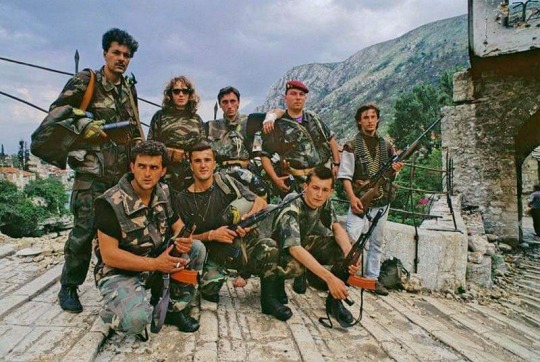#american defense manufacturing
Text
Have an interview for a position at a different manufacturer that both pays better than my current position and has a four day work week but after a little bit of research they have contracts with the DOD

2 notes
·
View notes
Text
capitalism really is the root of all evil huh
#thought about the existence of the american military industrial complex and got so angry i couldn’t see straight#the fact that over 35000 gazans have been killed and thousands more are displaced and starving is horrific on its own#but the fact that weapons manufacturers and defense contractors are PROFITING from it??? nauseating. absolutely fucking vile.#em speaks
0 notes
Text
St. Paul, MN – During the early morning hours of November 20, 50 pro-Palestine protesters gathered at the site of Lockheed Martin’s new microelectronics subsidiary, ForwardEdge ASIC, in Saint Paul. They unfurled long banners, one reading, “MN, divest from Lockheed,” and blocked the driveway entrances to the facility for almost eight hours.
Police arrived shortly after the activists occupied the space and made their presence throughout the day, but no arrests were made. Due to the protesters’ presence, no employees of ForwardEdge ASIC were able to enter the facility and go to work that morning. The parking lot remained empty save for a lone security guard’s vehicle.
Lockheed Martin is the world’s largest weapons company by revenue and one of the major suppliers to the Israel Defense Forces. Lockheed Martin supplies Israel with a wide variety of weapons, including fighter jets, attack helicopters, and missiles. Lockheed Martin technologies are also integrated into Israel's main weapon systems.
Activists participated in as part of the newly formed Free Palestine Coalition in the Twin Cities, which comprises groups such as the Anti-War Committee (AWC), American Muslims for Palestine – MN, Council on American-Islamic Relations – MN, Students for Justice in Palestine – UMN, Students for a Democratic Society – UMN, Women Against Military Madness (WAMM), Jews Against Genocide, Red Nation, and several others.
Protesters emphasized the role of the state of Minnesota in funding Lockheed as well as other companies that make possible Israel’s violence against Palestinians. “Minnesota granted Lockheed over $1 million to open the Saint Paul facility this year,” explained Wyatt Miller of the AWC. “Meanwhile, the State Board of Investments has invested over $53 million of public pension money it controls in Lockheed. Governor Tim Walz chairs that board, so we also want to send a message that Minnesotans don’t want to see our taxpayer dollars used to fund this massacre in any way.”
After protesters determined that a majority of the workday had been disrupted, they marched in unity towards the facility to plaster the building with the protest signs as a show of victory.
Sarah Martin, a longtime anti-war activist with WAMM who was prepared to be arrested Monday, stated, “Because of our presence, weapons components were not made at the facility today by a manufacturer largely responsible for the murder of Palestinian children.”
“Protesters across the world have been shutting down business as usual as long as this massacre of Gaza continues,” said Miller. “We are proud to do what we can to slow the operations of the U.S. military-industrial complex, which is the backbone of Israel’s oppression of Palestine.”
1K notes
·
View notes
Text
Things Biden and the Democrats did, this week #10
March 15-22 2024
The EPA announced new emission standards with the goal of having more than half of new cars and light trucks sold in the US be low/zero emission by 2032. One of the most significant climate regulations in the nation’s history, it'll eliminate 7 billion tons of CO2 emissions over the next 30 years. It's part of President Biden's goal to cut greenhouse gas emissions in half by 2030 on the road to eliminating them totally by 2050.
President Biden canceled nearly 6 Billion dollars in student loan debt. 78,000 borrowers who work in public sector jobs, teachers, nurses, social workers, firefighters etc will have their debt totally forgiven. An additional 380,000 public service workers will be informed that they qualify to have their loans forgiven over the next 2 years. The Biden Administration has now forgiven $143.6 Billion in student loan debt for 4 million Americans since the Supreme Court struck down the original student loan forgiveness plan last year.
Under Pressure from the administration and Democrats in Congress Drugmaker AstraZeneca caps the price of its inhalers at $35. AstraZeneca joins rival Boehringer Ingelheim in capping the price of inhalers at $35, the price the Biden Admin capped the price of insulin for seniors. The move comes as the Federal Trade Commission challenges AstraZeneca’s patents, and Senator Bernie Sanders in his role as Democratic chair of the Senate Health Committee investigates drug pricing.
The Department of Justice sued Apple for being an illegal monopoly in smartphones. The DoJ is joined by 16 state attorneys general. The DoJ accuses Apple of illegally stifling competition with how its apps work and seeking to undermining technologies that compete with its own apps.
The EPA passed a rule banning the final type of asbestos still used in the United States. The banning of chrysotile asbestos (known as white asbestos) marks the first time since 1989 the EPA taken action on asbestos, when it passed a partial ban. 40,000 deaths a year in the US are linked to asbestos
President Biden announced $8.5 billion to help build advanced computer chips in America. Currently America only manufactures 10% of the world's chips and none of the most advanced next generation of chips. The deal with Intel will open 4 factories across 4 states (Arizona, Ohio, New Mexico, and Oregon) and create 30,000 new jobs. The Administration hopes that by 2030 America will make 20% of the world's leading-edge chips.
President Biden signed an Executive Order prioritizing research into women's health. The order will direct $200 million into women's health across the government including comprehensive studies of menopause health by the Department of Defense and new outreach by the Indian Health Service to better meet the needs of American Indian and Alaska Native Women. This comes on top of $100 million secured by First Lady Jill Biden from ARPA-H.
Democratic Senators Bob Casey, Tammy Baldwin, Sherrod Brown, and Jacky Rosen (all up for re-election) along with Elizabeth Warren, Cory Booker, and Sheldon Whitehouse, introduced the "Shrinkflation Prevention Act" The Bill seeks to stop the practice of companies charging the same amount for products that have been subtly shrunk so consumers pay more for less.
The Department of Transportation will invest $45 million in projects that improve Bicyclist and Pedestrian Connectivity and Safety
The EPA will spend $77 Million to put 180 electric school buses onto the streets of New York City This is part of New York's goal to transition its whole school bus fleet to electric by 2035.
The Senate confirmed President Biden's nomination of Nicole Berner to the Court of Appeals for the Fourth Circuit. Berner has served as the general counsel for America's largest union, SEIU, since 2017 and worked in their legal department since 2006. On behalf of SEIU she's worked on cases supporting the Affordable Care Act, DACA, and against the Defense of Marriage act and was part of the Fight for 15. Before working at SEIU she was a staff attorney at Planned Parenthood. Berner's name was listed by the liberal group Demand Justice as someone they'd like to see on the Supreme Court. Berner becomes one of just 5 LGBT federal appeals court judges, 3 appointed by Biden. The Senate also confirmed Edward Kiel and Eumi Lee to be district judges in New Jersey and Northern California respectively, bring the number of federal judges appointed by Biden to 188.
#Thanks Biden#Joe Biden#Democrats#politics#US politics#climate change#climate crisis#student loans#debt forgiveness#shrinkflation#women's health#drug prices
445 notes
·
View notes
Link
(..)Production at the Giga Berlin-Brandenburg plant started later than originally planned (in March) due to long waits for permits. The ramp-up is also progressing slower than anticipated, as according to Electrek, a level of 1,000 units per week should have been achieved in April. The rumored main bottleneck was the paint shop's output. Tesla currently produces in Germany only the Tesla Model Y Performance version, powered by 2170-type cylindrical battery cells, as far as we know shipped from China (LG Energy Solution). Other versions (Long Range) and with new features (including structural battery pack) are in preparation(..)
#Tesla#Giga Berlin#ev manufacturing#very good news#fossil fuel phase-out#Germany#american car company#defense of europe#EU#electric vehicle#electric car#Tesla Model Y
1 note
·
View note
Text

Gee I wonder how common private gun ownership was right before the Russian revolution? Oh wait it was actually common and civilians could easily buy firearms. Here’s a print ad from the time:

Historically, many revolutions and civil wars involved the use of privately owned firearms. A really common pattern that you see going back hundreds of years is that at the outbreak of conflicts, civilians would form militias, arm themselves with whatever they could get their hands on, storm government armories, and then steal everything not nailed down.
During the Yugoslav civil war, the UN enacted an arms embargo on all sides of the war from Sept 1991 through the end of the war. The VRS split off from the JNA, so they just took those weapons with them. However, the ARBiH had to acquire weapons from a lot of different sources, such as:
Stolen from JNA barracks
Stolen from Yugoslav police
Taken out of museums (Yes, really. They were literally using vintage captured MG42s from WWII)
Handmade (!) (Yes, really. I saw handmade guns that were used in the war on display in a museum in Sarajevo)
Smuggled in by Pakistani Intelligence Services (Specifically anti-tank missiles)
Picture: A group of ARBiH soldiers at the Old Bridge in Mostar, June 1992. The man on the far right is carrying a Winchester Model 70 (captured from a Serb, who purchased it in Montana)

Picture: Two ARBiH soldiers, the one on the right is carrying an MG42.

Another conflict (or, more accurately, long series of conflicts) that we can also look to is the American Indian Wars. Native American combatants used a variety of weapons, but the weapons that they prized most highly were contemporary repeating rifles. Famously, repeating rifles such as the Henry lever-action rifle were contributing factors to the victory of Lakota and Cheyenne forces at the Battle of Little Bighorn in 1876. (Native Americans had been purchasing guns for hunting and combat for over a hundred years at that point. One of the earliest accounts of such a purchase was in 1750 where French traders traded flintlock muskets for horses from Wichitas and Comanches.)
Picture: The Apache military leader Geronimo, on right, accompanied by three younger warriors, 1886.

Let’s take another, ongoing example: The Myanmar civil war (2021- present, as of April 2024).
Fighters in the coalition of anti-junta forces use a wide variety of small arms, but most relevant for this post is the manufacturing and use of the FGC-9, a 9mm carbine compatible with Glock magazines.
(Side note: FGC stands for Fuck Gun Control.)
The FGC-9 design uses a combination of 3D-printed parts and easily-manufactured pressure-bearing metal parts.
Picture: a People’s Defense Force soldier carrying an FGC-9.

If you genuinely believe that there will be a revolution or civil war in your country in the future, then logically it is 100% reasonable to buy and train with guns right now.
If you genuinely believe that there will be a revolution or civil war in your country in the future, it makes absolutely no sense to hand-wave that away with “one day when the exact right circumstances emerge for a proletarian mass movement to Do Revolution, only then will we acquire even one single firearm. I’m just going to assume there won’t be massive obstacles such as arms embargoes, government crackdowns, or supply-chain issues that could completely stymie our ability to do that.”
If you genuinely believe that there will be a revolution or civil war in your country in the future wouldn’t it be better for the people on your side to already have some level of training & skill with firearms?
If you live in a country where the right wing has spent decades buying guns and salivating over the idea of starting a civil war and killing left-wingers and minorities, do you think it is a good idea to discourage left-wingers and minorities from buying guns?
170 notes
·
View notes
Note
I love your young wizards books! There’s an article in the NYTs about “plumes of steam” floating up from the belly of Manhattan and thanks to YW, I know it’s just dragons. ❤️
Thank you!
...And yeah, dragons, absolutely. :) (...Well, these guys, anyway.)

Via the Errantry Concordance: the Fireworm (Lanthanodrax speleotraxis)1
(Also the occasionally occuring “sport” or hypotrophic subspecies, L. speleotraxis ignigastris.) The colloquial name is identical with that used for the marine bristleworm Hermodice carunculata, but the two species otherwise have nothing to do with one another.
The wizardly fireworm is a serious competitor for the title of “North American fauna species that has had its evolution most seriously interfered with by wizardry.”
The original species — just another small reptile, to start with, a member of the suborder Lacertilla and a distant relative of the geckos — was repeatedly mutated by the wizards caught up in the events surrounding the final fate of Afallonë. The most comprehensive change to their structure happened as a side effect of the great aphthonic intervention, the wizardry intended to save as much as possible of the unique Atlantean flora and fauna from the impending destruction of the First Continent. The rafting wizardry which was meant to simply transport a number of species to the newer continents went wrong during the final crisis in many important ways, and rampant wizardry leakage contaminated and disrupted the genetic structures of many of the creatures involved. The fireworm, already susceptible to such disruption because of previous genetic manipulation, suffered far more of it during the transport to the early versions of North America and Europe than any other creature involved in the ancient rafting project.
In Europe and Asia, the fireworm had fewer natural enemies, and grew and changed in ways which would otherwise have been impossible. Further mutations due to the accumulation of wizardly overlays in the more populated parts of Europe led to the rise of the offshoot species Draco, the “true dragons” which became famous in Europe’s medieval period for being killed by knights. (It should be made clear that most of these casualties were members of the species Draco ectenis, the lindworm or wingless dragon, an omnivore by habit and cave-dweller by preference. Even the most heavily armored knights had a terrible batting average against Draco draco europaeis, the cliff-dwelling, strictly carnivorous winged dragon, which regarded knights merely as a somewhat-seasonal comestible delicacy with a crunchy outside and a yummy inside.)
But in North America, where many “rafted” species with wizardly components survived for the next few millennia after the fall of Atlantis, the fireworm kept for some time its original Atlantean form — that of a small carnivorous reptile with a tendency to burp flammable gas as a defense mechanism when frightened or upset. (No carbon-based dragon, true or false, breathes fire: but even the smallest ones can ignite it on exhalation in one of a number of ways, usually involving chemical or enzymatic reactions.)
However, unfortunately for the fireworm, its main Atlantean natural enemy the “king-weasel” (Macrogulo gulo, long extinct and survived only by its far less assertive “family” relative Gulo gulo, the wolverine) succeeded in establishing itself in North America as it had not been able to do in Europe because of the presence of the great crested cockatrice (Cerastus baseliensis) or northern cockatrice (Cerastus scotodasos). The king-weasel nearly succeeded in exterminating the fireworm. Only the smallest members of the family survived by changing their normal above-ground habitats for an underground lifestyle into which the king-weasels would not follow them.
After some millennia spent living and rebuilding their gene pools in the natural caves of the East, the fireworms moved into the manufactured caves and underground spaces of the great East Coast and Midwest cities. (No fireworm species live west of the Rockies. Possibly due to uncomfortable genetic memories secondary to the fall of Afallonë, they will not stay in earthquake-active zones.) Regardless of what ConEd tells you, fireworms are the proximate cause of the steam New Yorkers see coming up from under the streets in all weathers — the more steam, the larger the fireworm.
They are some of the most exothermic of all Earth-based life forms, when well-fed, and the very biggest ones can prosper down in the tunnels in even the coldest weather. When exposed to further wizardry leakage, as sometimes happens in the neighborhood of worldgate complexes, the oldest and most experienced fireworms can over time acquire some telepathic and empathic abilities.2 This enables them to force the smaller fireworms, and even members of some other species, to do their will — shepherding food into their ambit, or otherwise serving their needs. For this reason, smart wizards stay out of places where the older and larger fireworms can be found, unless the needs of errantry drive them there.
Fireworms are also the ultimate source of all the stories about “alligators in the sewers.” There is a certain ironic humor to this, as wizards know there wouldn’t be nearly so many stories if the things in the sewers were only alligators.
(See also: Eldest, the: Twelve, Song of the.) (SYWTBAW)
1The taxonomy of the western European fireworm is somewhat confused. The Bestiarium Ignotum classified the fireworm as Lanthanotrops micrognotus, but this did not take into account the internal differences between the Lanthanotrops and Lanthanodrax families — possibly understandable, since Linnaeus was unable to find a dead specimen to dissect, and trapping a live one was at that point out of the question. The Acta Parabiologica‘s revised classification group places the fireworm among the various members of family Hemerothalcus, with the “true dragons” of the Draco species.
2 Because of the already-fragile state of their DNA, such exposure over prolonged periods can also result in memory loss and other neurological problems, as seems to have been the case with the Eldest in SYWTBAW.
#Young Wizards meta#fireworms#Lanthanodrax speleotraxis#Young Wizards#So You Want To be A Wizard#unnatural history
98 notes
·
View notes
Text
A few thoughts on the student protests for Palestine in the USA (and elsewhere) - I am seeing some leftists worrying that coverage of these protests will draw attention away from the genocide. Attention on news & social media is not zero-sum, and there's an increasing dearth of up-to-date info on Palestine as the average person's attention has waned. Western media is naturally inclined to devote more coverage to domestic issues, and taking up as much of this as possible with news related to the genocide can only be a good thing. Local protests against colleges or other organizations doing business with weapons manufacturers etc. also aids the larger story of international support, for which I've seen nothing but joy from Palestinian citizens and journalists.
The USA student protest movement is also a fertile place for building solidarity regarding other issues like labor and for future movements. More action = more experience = stronger coalitions. Many of the groups coordinating support for these protests were formed to fight local police brutality, queer discrimination, or union busting. The current protests are gathering greater attention because of the skills and relationships these groups already have in place. If these protests had zero effect on the universities divesting from Israeli companies, they'd still be useful for radicalizing and strengthening groups on campus and for sending a message of support to the people of Palestine.
Anyway, the central question has always been "what should Americans be doing to support Palestinians & end the genocide?" And I think students leveraging their positions to sever relationships between their universities and the groups causing the genocide is a great step in addition to all the other work being done: protesting the USA government, divesting from Israeli + American weapons manufacturers (like Elbit & Lockheed Martin) and the American businesses working with them (Google & Amazon have a lucrative cloud computing contract with Israel, Microsoft works with their Ministry of Defense), donating eSims so Gazans have internet access, etc etc
Lastly, the making fun of the protestors for being privileged or how they react to being brutalized (e.g. yelling about being a professor)? You know this is not useful. C'mon guys. We share a common goal.
72 notes
·
View notes
Text
21 Oct 23
President Joe Biden is making a new case to the American public for shipping arms, ammunition and other military supplies to the wars in Ukraine and Israel.
His argument: many of those supplies are made in America — and that’s good for American jobs.[...]
That argument — which namechecked 2024 battleground states Pennsylvania and Arizona — comes as Biden makes a reelection pitch centered on his efforts to create jobs and revitalize domestic manufacturing in sectors such as clean energy and semiconductor fabrication. [...]
And now that message includes arms manufacturing. The administration is pushing to ramp up the defense industrial base to pump out more artillery shells, missiles and other weapons for the U.S. and allies. The newest aid proposal, released Friday, includes $61.4 billion for Ukraine, of which $30 billion is for direct Ukrainian military aid.[...]
For Democrats who have been eager to see Biden more actively selling the war supply effort to weary voters, the made-in-America angle is a welcome sign of political vigor. They acknowledge, though, that it is not a sure-thing political wager.
“To anybody that actually wants to, in good faith, make the decision, it’s certainly a really important and, I think, persuasive argument that this is about American jobs. It’s about helping actually bolster our entire defense manufacturing enterprise,” said Rep. Pat Ryan (D-N.Y.). “But I fear, and past behavior has shown, the MAGA extremists aren’t actually making this decision in good faith. They’re making it based on Russian propaganda that’s been propagated by Trump and everybody else.”[...]
While Biden’s message might resonate with some voters, it’s not getting much traction with House Republicans who oppose more aid [to Ukraine] at least not yet. Interviews with House GOP lawmakers on Friday showed that even those who feel Ukraine aid is justified aren’t buying Biden’s argument.[...]
Ukraine has been striking Russian logistics hubs using Lockheed Martin’s Guided Multiple Launch Rocket System, or GMLRS, that are partially made in Lufkin, Texas — a city of 34,000 people that saw its paper mill and foundry close over the last two decades.
It’s represented by Republican Rep. Pete Sessions, a Ukraine aid supporter, who said Friday that the U.S. has an obligation to protect Ukraine under its post-Cold War security commitments. [...]
The U.S. has awarded hundreds of millions of dollars in contracts for the High Mobility Artillery Rocket System launchers that fire GMLRS and are made in Camden, Ark., a town of about 10,000 people that’s 100 miles south of Little Rock.
Republican Rep. Bruce Westerman, who represents Camden, said critics of government spending can be surprised to know some of that spending is going back to communities like his.
“I actually had some constituents text me last night and say $100 billion is a lot of money to give away, and I made the point that a lot of that equipment is made in my district,” Westerman said. [...]
A bigger driver for House Republicans to back Ukraine aid may ultimately be whether they can extract border security concessions from Biden and Senate Democrats. Biden’s supplemental request includes $13.6 billion for security efforts at the U.S.-Mexico border.
Republicans are also seeking border policy changes from the administration, and see a Ukraine funding request as an opportunity for leverage.
“I’d be really surprised if Republicans wanted to let Russia win more than they wanted our own border secure,” Crenshaw said. “So I think that is the grand bargain that needs to happen.”
135 notes
·
View notes
Text
In 2022, America’s top five weapons contractors made $196 billion in military-related revenue, according to Defense News. Lockheed Martin dominated all other defense-focused companies, with total military revenue of roughly $63 billion last year. RTX, formerly known as Raytheon Technologies, was a distant second, earning roughly $40 billion in revenue in 2022.
The same five American “prime” contractors have long dominated lists of the world’s biggest arms manufacturers. Lockheed Martin, Northrop Grumman, RTX, Boeing and General Dynamics have remained in the top seven of the Defense News ranking since it began in 2000.
x





Some other fun facts:

Did you know Amy's dad was Shell the Oil Company's lawyer? They were actively lying about climate facts and denying climate change.
Kavanaugh, Alito, & Barret live within 10 minutes of these
None of them live further than 30 minutes from a weapons HQ. I checked.
So if you're ALREADY protesting in the are then consider paying them a visit so they don't feel left out ❤️
PS:
"A spokesperson for the Pine Bluff Arsenal did not respond to questions about whether the Israeli military is using white phosphorus munitions manufactured at the facility.
[...]The Pine Bluff Arsenal is not the only weapons manufacturer in Arkansas. In October, the defense contractor RTX Corporation announced it was building a new facility in East Camden in partnership with an Israeli defense contractor that will manufacture missiles to be used for Israel’s Iron Dome air defense system and its U.S. counterpart, SkyHunter. This facility will be the latest addition to a sprawling industrial complex that includes other defense contractors such as Lockheed Martin."

....the open secrets and donors for these guys is weird as hell for somewhere that should be boring af. It's def because of it's MD's military arsenal and it's definitely because these guys take money for it's use. They gotta go ASAP.
#idk what to tag this#things you should know#Palestine#USA#Israel#us politics#weapons manufacturers#NRA#Arkansas#Virginia#Maryland#boeing#lockheed martin#supreme court#follow the money
82 notes
·
View notes
Photo

Depending on who you talked to, James Jackson was either a con man, a genius, a degenerate gambler, a reincarnated shaman from ages past, or some combination of all four. “Jim”, as his friends and detractors called him, was a strange man. He was a self-educated thinker who was absolutely convinced that he was possessed of talents that approached the supernatural.
He may have been right: in the history of American enterprise there was no one quite like Jim Jackson. His overall demeanor and presentation to all who interacted with him was that of a self-styled cowboy; he wore ostrich-leather boots, always had a Marlboro cigarette in his mouth, and owned a ten gallon hat in every color in the catalog, and spoke with a drawl so thick that he could easily be mistaken for a man out of time. This man, who came to embody every myth of the western oilman and whose exploits would someday captivate a nation, had not stepped foot in Texas until his twentieth birthday. He never made a dime from oil.
Jim was born in Boston on July 16th, 1945 at the exact instant that the first atomic bomb was detonated two thousand miles away in New Mexico. He was the youngest of four children to Walter and Evelyn Jackson; Evelyn was a classically-trained stage actress who came from old money tied up in real estate in the northeast. Walter was a prolific and brilliant chemist who directed a research group for Bell Telephone Laboratories. During the war, Walter’s team was instrumental in developing the membranes necessary for the gas-diffusion method of enriching uranium for the Manhattan Project. Walter moved his family from Boston to San Jose, California in 1949 to partner with one of his former colleagues in founding a new applied science company. This new venture, Allied Micromaterials Corporation, would become one of the pioneering institutions in the development of semiconductors and later transistors. Contacts Walter had maintained in the defense department led to Allied receiving a contract to manufacture guidance systems for a new range of ICBM missiles, and by the middle of the 1950s, Walter was a very wealthy man.
As a boy, Jim was bright but had no patience for school. On several occasions he was found cutting class to wander along a creek that ran through the family’s estate. The land had been an apricot orchard before being purchased by his father, and a young Jim spent every spare minute he could find playing cowboy in the pastoral grove of trees. His patient mother indulged his fantasies and sent him to dude ranches and paid for horse riding lessons in the hopes it might instill a sense of discipline. By Jim’s sixteenth birthday he was showing signs of restlessness in the rapidly-urbanizing Californian environment, and entered into frequent arguments with his exasperated father. When he told Walter that he had no interest in attending college, and instead mentioned the then-escalating conflict in Vietnam, his father shouted him down. Angry but determined, a seventeen year old Jim walked to an army recruitment station the very next morning. It was of no use, however; through Walter’s many ties to the U.S. defense industry, it was essentially guaranteed that Jim would never see combat. For the young man who yearned to see the world and longed for an adventure to break the monotony of his sheltered upbringing, this was the final straw.
On a spring day in 1962, James Jackson packed a small bag and left home. From San Jose he took a train to Carson City, Nevada with the intent of finding work at one of the horse ranches from his childhood. When he arrived, a new subdivision had taken its place, with any traces of the ranches long gone. For two months he washed dishes in a casino buffet in Reno to pay for accrued gambling debts. From Nevada he hitchhiked to Idaho where he cut onions for 80¢ a day until the winter season forced him to move on. For three years he stumbled from job to job, lumberjacking in Washington state, fitting irrigation pipe in Arizona, welding in Alaska, mining Molybdenum in Colorado, and eventually working as a roughneck in an oilfield outside of Odessa, Texas. These three years had hardened young Jim and for the first time he felt at home among the wildcatters and oilmen in the dust and sun of west Texas. The challenge of the work invigorated him. The harsh conditions of the desert inspired him. The boom-bust cycle of the petroleum industry, however, did little to help secure the human needs of food and shelter. The men who made the real money on the drilling sites, Jim had noticed, were the geologists; those who only found the oil and didn’t stick around to do the hard work of pulling it out of the ground. Jim was charismatic, and it wasn’t long before he found work as an assistant for a local surveying office and began to learn the fine art of finding things underground. (edited)
He was almost ready to settle down when he received a call from home: His father had suffered an intracranial aneurysm and had died before emergency medical treatment could be administered. For the first time in years, he went home. In the days after Walters funeral, Jim was forced to confront his future. Jim was twenty, with little occupational prospects, but now had a twenty-five thousand dollar inheritance; enough in 1965 to get into nearly any business he wanted. He knew he still didn’t have the patience for college, and he had already figuratively “gone west.” Out of either a feeling of guilt, or a desire to not cause any further trouble to his family in California, he returned to Texas with the goal of finally striking out on his own.
By 1973, James Jackson was a man who, at least on the surface, betrayed no insecurities about his expertise. He exuded confidence and, after a few lucky breaks locating petroleum where none was thought to have existed, was billed as a “guru of the underground”. A small office was leased in Midland, a clerk and eventually a geologist, a few engineers and surveyors were hired. For a short time it was a mundane but generally honest living. What he lacked in experience as the chief of the small firm he more than made up for in the energy and zeal he brought to every job he undertook. He detested office work and would personally show up to every site, rain or shine, with the enthusiasm and showmanship of a circus ringmaster.
The job for Dale Whitmer was no exception.
1K notes
·
View notes
Quote
While it can be argued that war is good for the military-industrial complex, filling the coffers of arms manufacturers with billions and billions of dollars, we must ask whether this sort of spending is good for Americans as a whole. Taxpayers directly fund the U.S. military machine. The Israeli bombs falling on innocent Palestinians are bought and paid for by you and me. When we see gruesome pictures of war carnage and death, we must not avert our eyes from our handiwork. We are to blame. Until we force elected officials to change spending priorities, the U.S. government will continue to spend over a trillion dollars a year on defense and security. The total amount of money is limited, so what we fund reveals our priorities; our moral and ethical values.
Biden Continues to Preach Up the Myth that War is Good for the U.S. Economy
43 notes
·
View notes
Text
Germany Should Have Listened to Trump
Tuesday 2.27.2024 Wall Street Journal
By Walter Russell Mead
Trump was right about Berlin’s self-defense and risky energy dependence on Russia.
The lower house of Germany’s Parliament voted to legalize the recreational use of cannabis last week. It was a timely move. Germany’s leadership class is going to need all the mellow it can find in a world that isn’t going Germany’s way.
Russian advances in Ukraine and American paralysis over the next aid package are reinforcing the reality that Germany needs to defend itself but lacks the power to do so. So are developments in the Red Sea, where German manufacturers must cope with shipping delays as the Biden administration fails to keep the vital waterway clear.
Forget the 2% of gross domestic product that Germany has repeatedly promised and failed to spend on defense. Defense Minister Boris Pistorius shocked many observers this month when he said that in the new world situation, Germany may have to spend as much as 3.5% of GDP for defense.
The economic news is also grim. Last year Germany’s GDP shrank 0.3%, and last week the government slashed 2024 growth estimates to a pitiful 0.2%. Economists expect negative growth during the first quarter of 2024, placing the country in recession. The outlook for housing is bleak, with business confidence reaching all-time lows. The news in manufacturing is little better. This month the widely followed HCOB German Flash Composite Purchasing Managers’ Index fell to 46.1, the eighth month in a row that the index has pointed to decreasing economic activity.
Energy prices are a particular sore spot. The chemical giant BASF announced €1 billion in spending cuts in its German operations, blaming a mix of weak demand in the German market and “structurally higher energy prices.” Enormous U.S. subsidies under the so-called Inflation Reduction Act are leading German companies to look across the Atlantic.
Chinese competition is another massive worry. China long ago passed Germany as the world’s largest car producer. Increasingly, especially in electric vehicles, it is challenging Germany as both a low-cost and high-quality manufacturer. Beijing aims to marginalize German capital goods and automobile companies in China while Chinese exporters challenge German dominance in world markets.
With the associations representing the small and medium-size Mittelstand firms that make up the heart of the German economy warning in a rare joint open letter about Germany’s loss of competitiveness, Economy Minister Robert Habeck isn’t mincing words. The economy is in “rough waters.” The “competitiveness of Germany as an industrial location” is in doubt.
It isn’t all doom and gloom. The outlook for the service sector is brighter than for manufacturing, and as the Journal reported last week, the Ifo Institute’s business-climate index improved slightly this month. The best that can be said for the outlook? “The German economy is stabilizing at a low level,” according to Ifo’s president.
Meanwhile, Germany’s dysfunctional three-party coalition government is paralyzed by internal struggles. The largest party in the coalition, Chancellor Olaf Scholz’s Social Democratic Party (SPD), is deeply divided over foreign policy, with many nostalgic for good relations with Russia and allergic to military spending. The SPD also wants Biden-like government spending initiatives to revive the German industrial machine and expand social benefits. The Greens, the next-largest party, are by German standards foreign-policy hawks but continue to press for a rapid energy transition that drives up costs for business and consumers. The third party in the coalition, the Free Democrats, wants to hold the line on government spending. As if this weren’t enough trouble, the conservative opposition parties have a blocking minority in Parliament’s upper house.
This is not where Germans thought they would be. Sixteen months ago, I visited Berlin and heard from a stream of government officials, think tankers and economists that everything was working fine. Russia was failing in Ukraine. The energy transition would boost German competitiveness and employment. Germany’s Mittelstand would handle anything China could throw at it.
Under the circumstances, it’s no surprise that antiestablishment parties are growing in Germany. The far right Alternative for Germany (AfD) currently has more support than any of the governing parties, with one recent poll showing the AfD at 19%, the Social Democrats at 14%, the Greens at 13%, and the Free Democrats at 4%.
The most bitter pill of all for Germany’s establishment may be the realization that on the most important issues facing Germany, Donald Trump was right where they were wrong. Getting in bed with Vladimir Putin for cheap energy was both foolish and deeply disloyal to the West. German defense policy was self-defeating and dangerous. China wasn’t a reliable partner.
“Ich bin ein Berliner,” was President John F. Kennedy’s message to Germany. If Donald Trump returns to the White House, his message will likely be “Das habe ich gleich gesagt,” or “I told you so.”

#Today's#Wall Street Journal#Trump Was Right About Everything#trump 2024#trump#president trump#repost#donald trump#art#nature#democrats#Biden#Obama#love#Russia#Germany#landscape#fashion#leadership#honest#integrity#guts#energy#GNP#NATO#DIY#GIF#IG#Europe#listen
41 notes
·
View notes
Text
"Far from being exceptional in American history, gun-control regulations are the default. If 'Bruen' was designed to nullify the constitutional basis for many gun laws, it ought to fail."
--Robert J. Spitzer, political science professor emeritus at SUNY Cortland

Robert J. Spitzer, professor emeritus at SUNY Cortland outlines the early--and plentiful--history of gun regulation laws in early American history. Consequently, Clarence Thomas's 2022 Bruen decision might not be the disaster for gun control that some people have thought. Below are some excerpts from the article.

In the summer of 1619, the leaders of the fledgling Jamestown colony came together as the first general assembly to enact “just Laws for the happy guiding and governing of the people there inhabiting.” Consisting of the governor, Sir George Yeardley; his four councillors; and 22 elected “burgesses,” or representatives, the group approved more than 30 measures. Among them was the nation’s first gun law:
"That no man do sell or give any Indians any piece, shot, or
powder, or any other arms offensive or defensive, upon
pain of being held a traitor to the colony and of being
hanged as soon as the fact is proved, without all redemption."
After that early example of gun control came many more laws placing restrictions on the ownership and use of firearms. If guns have always been part of American society, so have gun laws.
This fact might come as a surprise to some gun-rights advocates, who seem to believe that America’s past was one of unregulated gun ownership. That view received a big assist in 2022, when the Supreme Court declared in "New York State Rifle & Pistol Association Inc. v. Bruen" that the constitutionality of modern gun laws depends on whether they are “consistent with this Nation’s historical tradition of firearm regulation.” In other words, the constitutional standard for any modern gun law boils down to whether you can find a good precedent for it back in the 1700s or 1800s.
The advocates’ assumption is that such precedents are few and far between, but thanks to the work of researchers and the digitization of archival material, thousands of old gun laws, of every imaginable variety, are now available for reference. Far from being exceptional in American history, gun-control regulations are the default. If "Bruen" was designed to nullify the constitutional basis for many gun laws, it ought to fail.
[...]
Throughout this long period in the history of the republic, up until the beginning of the 20th century, gun laws placed conditions or restrictions on weapons access for a wide variety of citizens—in particular, indentured servants, vagrants, non-Protestants, those who refused to swear an oath of loyalty to the government, felons, foreigners, minors, and those under the influence of alcohol. Numerous laws regulated hunting practices, as well as firearms’ carry, use, storage, and transportation; regulated the manufacture, inspection, storage, and sale of firearms; imposed gun licensing; and restricted dangerous or unusual weapons.
Despite the Thomas opinion’s claim that “the historical record yields relatively few 18th- and 19th-century ‘sensitive places’ where weapons were altogether prohibited,” some local authorities outlawed the discharge of firearms in or near towns, buildings, or roads, as well as after dark, on Sundays, at public gatherings, and in cemeteries. In some jurisdictions, any use of a firearm that wasted gunpowder was also an offense.
[...]
In the post-revolutionary 1800s, as rising violent crime led more people to arm themselves, a total of 42 states (plus the District of Columbia) enacted laws against concealed carry. Three more did so in the early 1900s, so that the total included almost every state in the Union. As many states from the 1700s to 1900s also enacted some form of weapons-licensing law.
That’s not all. Over that same period, at least 22 states restricted any gun carrying, including of long guns. Moreover, across the entire period, three-quarters of the states had laws either against “brandishing”—waving a gun around in a menacing or threatening manner—or merely having a weapon on display in public.
[...]
In addition, even though for much of its history America was an agrarian country...its lawmakers and enforcers were inventive and determined about ensuring public safety. When they perceived a threat to that order from firearms, they passed laws to restrict or prevent them. And back then, by and large, no court struck those laws down.
That is what is truly consistent with this nation’s historical tradition of firearm regulation. So if we accept the originalist premise of "Bruen," the actual result should be to render a broad array of gun regulations constitutional.
[color emphasis added]
#american history#gun control#america's original gun control#robert j. spitzer#bruen decision#the atlantic
91 notes
·
View notes
Text

Updated B-52 electronic warfare suite will be tested in flight in 2024
Fernando Valduga By Fernando Valduga 03/29/2024 - 10:36 in Military
Flying through the skies since the 1950s, the B-52 Stratofortress is a U.S. Air Force (USAF) workhorse and a lasting symbol of American military power. The eight-engine giant has unique capabilities unparalleled to any other American warplane - which is why, after more than 70 years of service, it continues to play a vital role in the defense and national security strategy of the U.S. And thanks to a collaboration between L3Harris and USAF, this iconic aircraft is prepared to remain ready for the mission against highly sophisticated emerging threats in the coming decades.
Under a 10-year contract worth $947 million granted in 2021, L3Harris is upgrading and improving the AN/ALQ-172 electronic war self-protection system (EW), which protects the B-52 and air crews from a wide range of electronic threats. Our current work is based on decades of experience in providing critical technology as a Manufacturer of Original Equipment of the AN/ALQ-172 systems for the B-52 fleet. And combined with other ongoing modernization efforts, these updates will increase the relevance and reliability of the B-52 by the 2050s.

L3 Harris AN/ALQ-172 systems.
"Our opponents continue to evolve, facing advanced and far-reaching threats that challenge our ability to operate in contested environments," says Robert "Trip" Raymond, USAF's Program Leader for EW Technology Development at L3Harris. "It is essential that we provide our B-52 crew with the necessary tools to keep the B-52 relevant, lethal and survivable as the backbone of the strategic bomber force of the United States."
The effort of modernization and support - ALQ-172 Maintenance and Reliability System (MARS) - intends to do exactly that, increasing the average time between failures due to its modular design, while further improving the performance, maintenance capacity and reliability of the system. Thanks to an integrated and improved radio frequency system, crews will be able to simultaneously combat multiple radar threats that interfere with aircraft operations. And by replacing analog systems with more economical software solutions, USAF will be able to reduce the size of B-52 crews from 5 to 4. This frees up resources for additional mission-critical activities.
Ultimately, the updates will further help USAF in its Global Attack Mission and strengthen the effectiveness of the B-52 in modern warfare, while making future upgrades cheaper and easier.
"We are implementing affordable solutions that not only reduce costs, but also provide crews with more advanced protection against the most sophisticated threats detected by radar," said Jimmy Mercado, Program Director at L3Harris. "All this results in a more modern, efficient and effective aircraft, ready to dominate the future struggle."
USAF plans to conduct a test flight with the new electronic warfare capabilities of the B-52 in 2024.
Tags: Military AviationBoeing B-52H StratofortressEW - ELECTRONIC WARL3HarrisUSAF - United States Air Force / U.S. Air Force
Sharing
tweet
Fernando Valduga
Fernando Valduga
Aviation photographer and pilot since 1992, he has participated in several events and air operations, such as Cruzex, AirVenture, Dayton Airshow and FIDAE. He has works published in specialized aviation magazines in Brazil and abroad. He uses Canon equipment during his photographic work in the world of aviation.
Related news
AERONAUTICAL ACCIDENTS
VIDEO: Russian Su-27 fighter in flames falls into the sea near Sevastopol
29/03/2024 - 09:43
An F-16 fighter from the Norwegian air force lands at a Turkish air base in the Turkish city of Konya, in Central Anatolia. Norway, a member of NATO, will donate F-16 fighters to Ukraine, whose forces are involved in a difficult counter-offensive against Russia. (Photo: AP / Burhan Ozbilici)
MILITARY
Putin threatens to attack NATO air bases that host Ukrainian F-16 fighters
28/03/2024 - 21:56
MILITARY
Retirement from F-22 in 2030 is unlikely, since USAF intends to spend $7.8 billion on it before that
28/03/2024 - 21:16
MILITARY
IMAGES: Inaugural flight of the first light combat aircraft Tejas Mk 1A
28/03/2024 - 18:27
Dassault Rafale Fighter. (Photo: Katsuhiko Tokunaga)
MILITARY
France tests Thales' IRST system update for Rafale F4.2 update
28/03/2024 - 15:00
MILITARY
Dutch drone fleet MQ-9A Reaper will receive tactical updates
28/03/2024 - 14:00
35 notes
·
View notes
Text
Nick Land on democracy
Democracy might begin as a defensible procedural mechanism for limiting government power, but it quickly and inexorably develops into something quite different: a culture of systematic thievery. As soon as politicians have learnt to buy political support from the ‘public purse’, and conditioned electorates to embrace looting and bribery, the democratic process reduces itself to the formation of (Mancur Olson’s) ‘distributional coalitions’ – electoral majorities mortared together by common interest in a collectively advantageous pattern of theft. Worse still, since people are, on average, not very bright, the scale of depredation available to the political establishment far exceeds even the demented sacking that is open to public scrutiny. Looting the future, through currency debauchment, debt accumulation, growth destruction, and techno-industrial retardation is especially easy to conceal, and thus reliably popular. Democracy is essentially tragic because it provides the populace with a weapon to destroy itself, one that is always eagerly seized, and used. Nobody ever says ‘no’ to free stuff. Scarcely anybody even sees that there is no free stuff. Utter cultural ruination is the necessary conclusion.
Within the final phase of Modernity 1.0, American history becomes the master narrative of the world. It is there that the great Abrahamic cultural conveyor culminates in the secularized neo-puritanism of the Cathedral, as it establishes the New Jerusalem in Washington DC. The apparatus of Messianic-revolutionary purpose is consolidated in the evangelical state, which is authorized by any means necessary to install a new world order of universal fraternity, in the name of equality, human rights, social justice, and – above all – democracy. The absolute moral confidence of the Cathedral underwrites the enthusiastic pursuit of unrestrained centralized power, optimally unlimited in its intensive penetration and its extensive scope.
With an irony altogether hidden from the witch-burners’ spawn themselves, the ascent of this squinting cohort of grim moral fanatics to previously unscaled heights of global power coincides with the descent of mass-democracy to previously unimagined depths of gluttonous corruption. Every five years America steals itself from itself again, and fences itself back in exchange for political support. This democracy thing is easy – you just vote for the guy who promises you the most stuff. An idiot could do it. Actually, it likes idiots, treats them with apparent kindness, and does everything it can to manufacture more of them.
47 notes
·
View notes